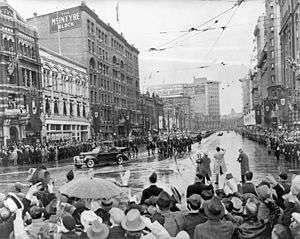Portage and Main
| Portage and Main | |
|---|---|
 | |
| Location | |
| Winnipeg, Manitoba, Canada | |
| Coordinates: | 49°53′44″N 97°08′18″W / 49.89545°N 97.13838°W |
| Roads at junction: |
|
| Construction | |
| Type: | at-grade intersection |
| Opened: | June 2, 1862[1] |
| Maintained by: | City of Winnipeg Public Works |
Portage and Main is an intersection in Winnipeg, Manitoba. It is located in the centre of downtown Winnipeg at the place where Portage Avenue (Route 85) and Main Street (Route 52) intersect. The corner is well-known across Canada as the "crossroads of Canada", due to its relative proximity to the longitudinal centre of Canada.
History

The land upon which Portage and Main sits was originally purchased by Henry McKenney on 2 June 1862. He chose land where the north-south and east-west ox cart paths crossed, in order to build a general store with his half-brother John Christian Schultz.[2][3]
Portage and Main is now the hub of some of Winnipeg's main transportation routes. It was once the centre for the banking industry in Western Canada. The national banks have branches accessible from beneath Portage and Main. It has served as a temporary city square and meeting place for parades and events, including the Winnipeg General Strike of 1919.
In 1974, the intersection was featured on an 8-cent stamp.[2]

In 1976, the City of Winnipeg signed an agreement with private developers to open an underground concourse linking shopping malls under the four corner properties.[4] This included a 50-year deal to permanently close the pedestrian crossings at the intersection, which street works were completed around 1978.[5] The concourse and walkways are connected through the Winnipeg Skywalk.[6] The Portage and Main Circus houses a concrete sculptural wall created by Bruce Head.[7]
On 13 August 1981, Portage and Main was the place where Dale Hawerchuk signed his contract with the Winnipeg Jets and later was the location of the "Save the Jets" rallies in 1995 and 1996.[8]
More recently, Portage and Main has served as an anchor point for occasional street festivals and the winter lighting of holiday street decorations.
Weather
Portage and Main is the brunt of popular jokes referring to it as the coldest and windiest intersection in Canada. The phrase Portage and Main has come to refer to the city of Winnipeg as a whole. The long-standing cold weather legend is unproven, because there are no official temperature measurements at any street corner in Canada to confirm the coldest intersection. Winnipeg's city centre is usually 3–4 °C warmer than the airport, owing to the urban heat island effect.
Cultural references
There are numerous cultural references to the intersection, including the 1992 Randy Bachman and Neil Young hit song “Prairie Town”, with the chorus repeating the line “Portage and Main, 50 below”. The British band Blurt have a song named “Portage & Main” on their album Kenny Rogers' Greatest Hit. It is also the setting for the Stompin' Tom Connors song "Red River Jane".[2] In his song "Free in the Harbour," Canadian folk singer Stan Rogers referenced Portage and Main as a stop for Hermitage Bay, Newfoundland fishermen on their way to find oil field work in "the hills of Alberta."
Portage and Main is a property on the Canadian Monopoly board,[2] and was the inspiration for Fort Garry Brewing Company's "Portage and Main" India Pale Ale.[8]
See also
References
- ↑ "Party for Portage and Main". Winnipeg Free Press. 2 June 2012.
- 1 2 3 4 "Things you might not know about Portage and Main". CBC News. 1 June 2012. Retrieved 22 January 2014.
- ↑ George F. Reynolds (2 June 2012). "The Man Who Created the Corner of Portage and Main". Manitoba Historical Society. Retrieved 22 January 2014.
- ↑ Winnipeg Square
- ↑ "The city agrees that it will not consent to any application for the construction of a pedestrian crossing over or under any street, avenue or other roadway within that portion of the city [within a block of Portage and Main] unless the applicant for such a crossing provides a direct connection between the proposed crossing and the Concourse." Agreement quoted in Consideration of the Report of the Committee on Works and Operations, December 16, 1976, p 290.
- ↑ maps at Winnipeg Square and at MTS Centre
- ↑ Bruce Head's biography at Ken Segal Gallery
- 1 2 VANDERHART, TESSA (13 August 2013). "Best intersection in Canada? Portage and Main nominated as one of Canada's Greatest Places". Winnipeg Sun. Retrieved 22 January 2014.
External links
- The Man Who Created the Corner of Portage and Main, Manitoba Historical Society Transactions